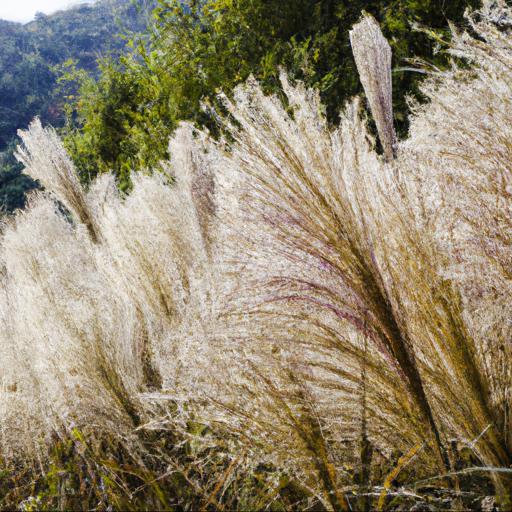Miscanthus nepalensis is a species of flowering plant native to the Himalayas. It is a tall, perennial grass with a long, arching stem and large, feathery leaves. The species is used for ornamental purposes, forage, and as a bioenergy crop.
It is known for its high yield of biomass and is gaining attention for its potential to become a sustainable source of energy. It is relatively easy to grow and can thrive in a variety of climates.
With its low input requirements and high yield, Miscanthus nepalensis has great potential to become an important part of the global energy mix.
Benefits of growing miscanthus nepalensis

Miscanthus nepalesis, commonly known as Nepalese Silver Grass, is a versatile and highly adaptable ornamental grass gaining in popularity in the UK. It has many advantages for UK gardens, making it a great choice for gardeners who want to reap the rewards of a low-maintenance, aesthetically pleasing garden.
Miscanthus nepalesis has beautiful feathery foliage, which stands out in the garden and shines in the UK climate. It grows quite tall, with the stems reaching up to two metres. While this may seem to take up a lot of space, its upright growth makes it a great space-saving option for small gardens.
The foliage also stays green for much of the year, creating an attractive landscape even in the winter months. It should be noted that in autumn, the foliage turns to a beautiful silver colour, this makes it a great choice for brightening up gardens in dull winter months.
In terms of maintenance, Miscanthus nepalesis really pushes the boundaries. It is naturally resistant to pests and diseases, needs minimal pruning, and lacks the need for regular fertilising and watering. This makes it the perfect choice for a dryer and hotter climate, as well as making it ideal for the busy gardener.
Additionally, its deep and extensive roots play an important role in preventing soil erosion, adding to its popularity in the UK. Finally, miscanthus nepalesis is an important source of food for many of the UK native birds.
Its long-lasting seed heads attract a wide variety of birds and other wildlife, adding to its overall appeal as an ornamental garden plant. For those looking for a low-maintenance yet attractive garden, you simply can’t go wrong with Miscanthus nepalesis.
How to plant and care for miscanthus nepalensis

Miscanthus nepalensis is a widely grown ornamental plant with its bold foliage and fascinating form. It is a majestic looking grass with silhouetted plumes that add height and a grandeur to the garden.
When planted and cared for properly, it can be a beautiful addition to any landscape. With its striking dark green foliage, it adds a dramatic presence to any garden. Having a proper plan in place before planting this beautiful grass is essential for its success.
You should choose a location that is full sunlight and in well-drained soil. This will help ensure its strong root system. After planting, you should be sure to give your Miscanthus nepalensis plenty of room to grow, allowing it to spread up to five feet in width.
Adding a thick layer of mulch around the root zone will help retain water and a layer of compost will help promote healthy soil. Once the Miscanthus nepalensis is established, it will require very little maintenance.
It should be watered regularly during drier times and pruned back in the early spring to help control its size. In addition, it will need to be fertilized in order to promote healthy growth. If the soil near the root zone becomes compacted over time, you should use a garden fork to aerate it.
This graceful grass adds a crown-like formation, when it is mature. If you are looking for a graceful and majestic addition to your garden, Miscanthus nepalensis is an excellent choice.
With proper care and patience, it can become the perfect addition to any garden.
Common pests and diseases of miscanthus nepalensis

. Miscanthus nepalensis is a species of grass native to parts of India, Nepal, and Bhutan, and is known for its tall, elegant form and striking purplish blooms.
It can be a great addition to any landscape, particularly those looking for a low-maintenance, drought-tolerant, and eye-catching ornamental. However, it is also susceptible to some common pests and diseases, and so must be vigilantly maintained and monitored in order to maximize its aesthetic and ecological value. The most common pests of Miscanthus nepalensis are aphids, spider mites, Japanese beetles, and caterpillars.
These insects can cause significant damage to the plant, including stunting its growth, reducing vigor and fertility, and weakening the leaves and stems. To combat these pests, it is important to regularly check plants for signs of infestation and to use appropriate insecticides if necessary.
Hand-picking and release of beneficial insects such as lady beetles, lacewings, and parasitic wasps are also effective methods for controlling some of these pests. Common diseases affecting Miscanthus nepalensis include rust, powdery mildew, smut, and several fungal leaf spots. These diseases can attack the leaves or stems and can cause the foliage to yellow and drop prematurely or even cause death of the plant.
Proper cultural practices such as maintaining adequate air circulation and avoiding overcrowding can help to reduce the spread of these diseases. In addition, systemic and preventive fungicides may be prudent to apply in some instances to further prevent the spread of disease.
In summary, Miscanthus nepalensis can be a wonderful addition to any landscape. However, it is important to be aware of the various common pests and diseases that can affect it in order to ensure its continued health and vigor. By regularly scouting the plants and following recommended cultural practices, gardeners can minimize the impact of pests and diseases and ensure the plants remain healthy and attractive in their landscape.
Final Touch
Miscanthus nepalensis is a species of grass native to the Himalayan region. It is a fast-growing, perennial grass that can be used for a variety of purposes, including forage, erosion control, biomass production, and ornamental landscaping.
Its deep root system and high tolerance for extreme temperatures make it an ideal choice for harsh climates. Miscanthus nepalensis is also highly drought-tolerant, making it an excellent choice for areas prone to water scarcity.
FAQ
What are the characteristics of Miscanthus nepalensis?
Miscanthus nepalensis is a perennial grass native to the Himalayan region. It is a fast-growing species with a clumping habit and can reach heights of up to 5 meters. It has long, narrow, green leaves and produces feathery, reddish-brown flower heads in the late summer. It is tolerant of a wide range of soils and climates and is drought-tolerant once established. It is also known for its excellent ornamental value and is often used as a ground cover or in landscaping.
What are the benefits of Miscanthus nepalensis?
The benefits of Miscanthus nepalensis include its ability to grow in a wide range of soil types, its ability to tolerate drought and flooding, its ability to sequester carbon, its low nutrient requirements, and its potential to be used as a biofuel.
Where is Miscanthus nepalensis found?
Miscanthus nepalensis is found in the Himalayan region, from Nepal to Bhutan, and in parts of India and China.
How is Miscanthus nepalensis used?
Miscanthus nepalensis is used as an ornamental grass, for erosion control, and as a source of biomass for energy production.
What are the potential uses of Miscanthus nepalensis?
The potential uses of Miscanthus nepalensis include forage, biomass production, erosion control, and soil improvement. It can also be used as a source of fiber for paper production, as a biofuel, and as a source of biochar.
What are the potential risks associated with Miscanthus nepalensis?
The potential risks associated with Miscanthus nepalensis include the potential for it to become an invasive species, outcompete native species, and alter soil chemistry. It can also reduce the availability of light, water, and nutrients for other plants, and may be toxic to some animals.

